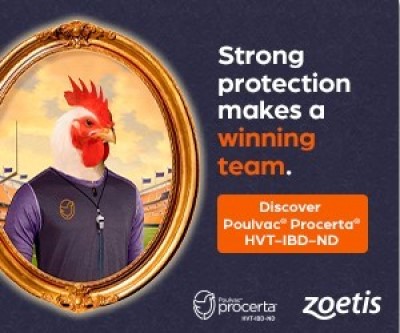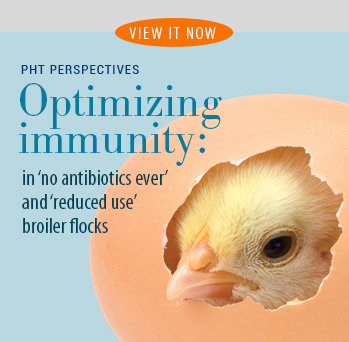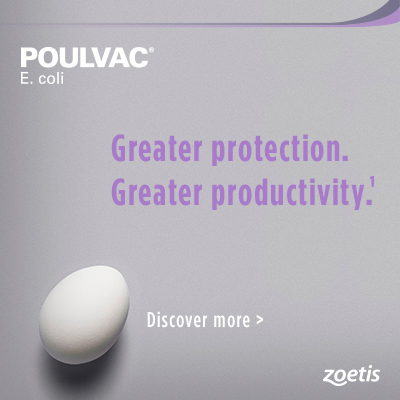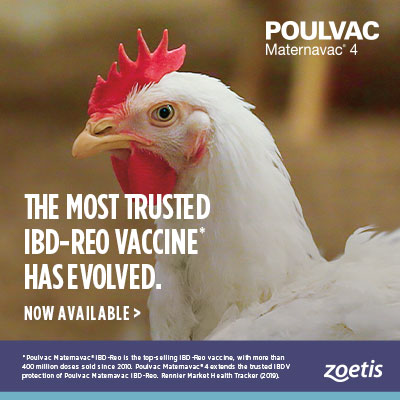When you can’t have more than one: HVT vector or live vaccine for IBDV?

An interview with Kalen Cookson, DVM, MAM, Director of Clinical Research, Zoetis
Q: Vectored herpesvirus of turkey (HVT) vaccines are popular for managing Marek’s and other diseases, but why can’t more than one be used in the same flock?
KC: It’s due to different HVT replication rates and the resulting expression of their inserted genes. If HVT vaccines are used for, say, infectious bursal disease (IBD) and Newcastle disease (ND), one often out-replicates the other and prevails. The loser would have reduced efficacy. That’s why only one HVT vaccine — recombinant or not — should be used at a time.
Q: How do you decide which one to use or whether to use one in the first place?
KC: It depends on disease pressure, season, proximity to other farms and especially on your other vaccine options. Determine where the HVT vaccine will deliver the most value and how your choice might affect vaccination strategies for the other diseases. For example, if respiratory diseases are your primary concern — often the case in winter — consider using an immune-complexed live vaccine to help protect against IBD and use an HVT vector vaccine for ND.
Q: But will a conventional live vaccine provide adequate IBD protection?
KC: I guess it depends on what you mean by conventional. In a controlled university study, researchers compared Bursaplex® — a classic live vaccine complexed with antibodies — to the recombinant Vaxxitek® HVT+IBD.1 Specific-pathogen-free leghorns received a single dose of either vaccine in ovo, then were challenged with classic IBD virus at 13 days of age.
Q: What were the results?
KC: Bursal lesion protection was 100% in the group receiving Bursaplex compared to 78.3% for birds vaccinated with Vaxxitek HVT+IBD. The difference between groups was significant (P ≤ 0.05). We also found protection against splenomegaly — an indication of viremia — was 95% in birds immunized with Bursaplex, versus 76.7% for Vaxxitek HVT+IBD. Here again, the difference was significant (P ≤ 0.05).
Q: Were there any advantages from a production standpoint?
KC: Yes. Weight gain after challenge was 45.9 g in the Bursaplex group and 42.6 g in the Vaxxitek HVT+IBD group, compared to only 21.0 g in unvaccinated controls.
Q: Do the results with Bursaplex hold up in the field?
KC: They do. We compared the same two vaccines in a winter-spring trial conducted at a US broiler complex processing nearly 2 million birds weekly.2 The company had a 3-point feed conversion improvement when vaccinating with HVT+IBD, but flocks still had an IBD challenge at 3 weeks and an infectious laryngotracheitis challenge was looming. This complex wanted to see if Bursaplex was a viable alternative to HVT+IBD so in the trial, one-third of flocks placed each week for a total of 9 weeks received Bursaplex in ovo instead of HVT+IBD.
Q: What were the results of the field trial?
KC: Based on bird performance, Bursaplex was at least as effective as Vaxxitek HVT+IBD in protecting against a high IBD challenge (Table 1). Neither group showed severe lymphoid depletion, suggesting at least partial protection, but the feed-conversion ratio adjusted to a 4-pound bird actually favored those vaccinated with Bursaplex by about 1 point (0.01).

Q: Both vaccines were given in ovo. How does maternal immunity figure into vaccine protection against IBD?
KC: If maternal IBD immunity is low and the challenge is high, birds will be susceptible to early infections. The HVT+IBD vector vaccine can minimize bursal atrophy compared to unvaccinated birds but often doesn’t prevent or limit field infection.2,3 Field infection pressure may challenge birds as early as 2 to 3 weeks of age — before significant immunity from the recombinant vaccine kicks in. In contrast, antibodies coating Bursaplex help protect the embryo or young chick from infection by the vaccine. It starts replicating when maternal immunity has fallen and the bird becomes vulnerable to field infection. You typically see moderate bursal atrophy between 3 and 4 weeks of age, but field infections can be reduced or even prevented.
Q: So, what’s your take-home message for broiler complexes?
KC: Bursaplex provided IBD protection at least equal to that of an HVT vector vaccine. As a live vaccine, Bursaplex had certain advantages against high, early field challenge and limiting field challenge replication. At the same time, it provided flexibility by enabling use of a recombinant HVT vaccine for other diseases.
1 Data on file, Study Report No. PET 21-12- 70AQO, Zoetis Inc.
2 Data on file, Study Report No. 014-14-70AQO, Zoetis Inc.
3 Data on file, Infectious Bursal Disease Virus PCR and Sequencing Report July 08, 2014, Zoetis Inc.
TOOLBOX, Issue 3
Toolbox is a series of interviews with veterinarians and other technical specialists about their experiences managing antimicrobials, vaccines and other tools for poultry health. It is produced by the editors of Poultry Health Today on behalf of the US Poultry Business of Zoetis.
BIO-00128
Mar 2017
Posted on November 30, 2018
 We’re glad you’re enjoying
We’re glad you’re enjoying















